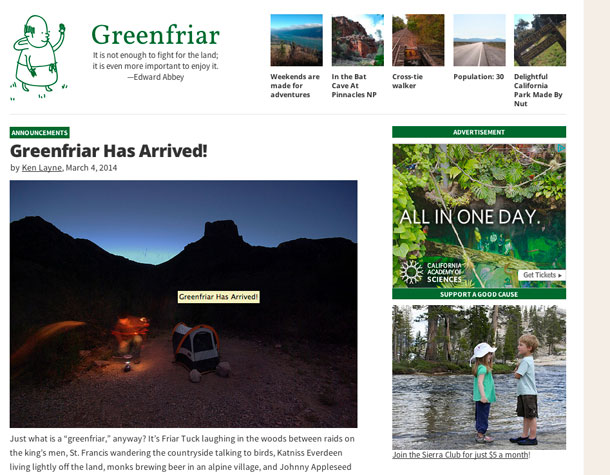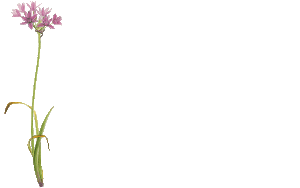It’s rare to see someone trying to bring a new nature publication into the world. But with the March launch of Greenfriar, Bay Area-based writer Ken Layne is doing just that. We talked by email about the new site, nature in the Bay Area, the wisdom of Edward Abbey and the enduring beauty of Point Reyes.
Eric Simons: So, Greenfriar.com. Describe what you’re doing there. What is this thing?
Ken Layne: I wanted something to read online that approached environmental issues, nature and sustainability in a more hopeful and personal way, while celebrating the victories, providing some comfort and aid. Especially on the West Coast, my friends live more or less as I do: We shop at farmers markets, try to walk and bicycle or take public transit to get around, keep organic gardens, and when we’re free of work and other such obligations we’re hiking and surfing and camping out. That’s a meaningful way of life, even if people don’t consciously think of it all as “active environmentalism.” It adds up to a very powerful philosophy that comes with a really enjoyable and fun life. That’s Greenfriar.
Since 2007 I’ve been wanting to do something like this, but hoping some better qualified people would do it first. And I kept waiting, doing my other media work, and eventually the ideas and the need became clear, so I got together with my comrades and we launched it ourselves.
ES: Right away, there’s Edward Abbey on the home page: “It’s not enough to fight for the land; it is even more important to enjoy it.” Why that quote as the Greenfriar mantra?
KL: I’ve always loved Abbey’s advice to young environmentalists, about being a part-time crusader. The main danger of environmental activism is the tremendous burnout rate. You have to keep yourself reasonably happy, you have to feed your soul with something other than apocalypse and End Times.
You can’t sugarcoat global warming, the loss of habitat and species. But unless we experience nature in a personal way, we run out of energy to fight. We open the mailbox and there’s another half dozen fundraising envelopes—a wolf with a bullet in its head, a sea turtle choked by plastic bag, it’s all so important but it’s also just crushing.
Don’t forget to take care of yourself, that’s what Abbey is saying. And by being an “active environmentalist”—being a living part of your natural environment, in the city and in the wilderness—you’re also an evangelist for a life of adventure and fun. That’s a seductive thing. Our friends on Facebook rarely post updates about how they sat at home in the dark eating leftovers and watching a repeat on television. They post the good stuff, walking on the beach with their kids, the garden coming up, backyard wildlife, running a marathon or hiking up Mount Whitney. That’s evangelizing to your friends and family and coworkers. It’s wonderful out there, and that’s where we fall in love with the natural world, again and again.
ES: So far you’ve got a combination of stories: travel tips, inspirational quotes, natural histories, first-person essays. Is there anything you’re particularly looking for to post?
KL: Anything from amateur adventurers is especially appealing to me, although Greenfriar has published pieces by botanists and science writers and biologists. A lot of conservation experts are so deep in their “enviro jargon” that they’ve forgotten how to talk to people. So I love to hear from non-experts like me, and I love when the pros shake off the language of EIRs and grants and let the profound thoughts tumble out.
We’re launching a new weekly column by a guy who’s going off the grid, but in Brooklyn! Just as “armchair travel” can inspire actual travel, reading about extreme approaches to our consumption of energy and other stuff can inspire someone reading from their office chair. We’re also profiling people who turned their beliefs into careers. I love to do these in Q&A format, like I did with Monica Bond and Derek Lee of the Wild Nature Institute. ( http://www.theawl.com/2013/03/quit-your-job-living-with-the-wild-things-without-compromise ) Everybody working for the cause, whether in environmental media or conservation or fighting climate change, they’ve all got a story about how they got there, how they turned concern into action.
ES: You just posted this story about (I think) feminist solo hiking in the Pinnacles, and Tweeted the quote from it: “Nature is so metal sometimes I can’t even deal.” That’s maybe not the voice we’re used to seeing in nature writing, which the writer notes in the piece. Do you have an idea in mind of the audience you’re going for, and is part of the idea that this is something different?
KL: There’s a lot of beautiful nature writing that’s florid and baroque, and that’s fine. We may have such stuff on Greenfriar, if people are still writing that way. Elizabeth Lopatto, who writes our weekly columns about her regional wanderings and solo hikes, is a well-known science reporter who can do the formal approach very well. But there’s such honesty and power in using your natural conversational language.
Not many of us sitting around a campfire in 2014 are using grand and ponderous rhetoric and rhapsody to discuss the day’s adventures, even when we’re writers. We are who we are, both in the city and out in wild nature. Like when I go to REI to get a pair of walking shoes and they ask me how often I hike, I say every day and I mean it. I walk out of my house and down to the beach and trudge through the sand and spot harbor seals and take phone pictures of the sunset and the shorebirds and pick up a six-pack on the way home. I don’t need a different language to describe that; it’s daily life, and our daily voice can do the job.
ES: You’re based in the Bay Area, and there’s a lot of good stuff for Bay Area residents and good writing from Bay Area-based writers, but it also comes with some level of national and global perspective. How much will the site continue to have a local feel to it?
KL: This is the birthplace of the conservation movement, and one of the most remarkable spots on the planet. It’s at the center of so much that goes on in sustainability, technology-driven conservation, green energy, local food, this whole Ecotopia ideal that’s happening in fits and starts right before our eyes. So there’s no way to avoid it, and no reason to avoid it. But in the months ahead you’ll see a lot more from the rest of North America, and occasional forays into the rest of the world.
But I believe very strongly in place and believe in being a partisan for your ecoregion. So that will remain an important part of Greenfriar, even as more writers from more places contribute essays and stories to our pages.
ES: You’ve been the editor of Wonkette, and a writer at Gawker – what made you decide to go from the East Coast politics and media scene to an Abbey-quoting startup nature blog in California?
KL: I’ve been a hiker and camper and public-lands roadtripper since the early 1980s. Earth First! cookouts, occasional mountain ascents, volunteering on the local Sierra Club paper, I was even lucky enough to meet Abbey and talk to him. (I’ve got the pile of signed, dog-eared paperbacks to prove it.) My East Coast work happened while I lived out West, in Northern Nevada and down by Joshua Tree National Park—thanks to the magic of the Internet.
Until five or six years ago, I didn’t have anything to say that would add to Nature Writing. So I kept my two lives more or less separate, although I was writing political satire and I did consider it a kind of patriotic duty considering the other side’s hysterical antagonism toward the basic moral duty of being good residents of this planet.
I was in the Grand Canyon when Occupy Wall Street began, and I got out to New York to see it happening, to hang out at Zuccotti Park, with the cops closing in and Pete Seeger leading everybody up to Columbus Circle. I had just written this little book called “Dignity,” about communities forming in the abandoned half-built desert developments after the 2008 economic collapse, and just generally felt radicalized again, even as Occupy itself fell apart without a structure to maintain it. Greenfriar is the slow-cooked result of all that. We need letters of encouragement, a good place to retreat for camaraderie and refreshment.
And if that’s outrageously overblown for a blog about day hikes and herb gardens, so be it. Small gestures can matter a lot.
ES: Are you from the Bay Area?
KL: I’m from New Orleans, originally, and first lived in San Francisco in the early 1990s. I’ve been a Californian more or less since 1979.
ES: You have a post category “Get Outside!”, which is clearly an exhortation, not a travel tip. So when you take your own advice, where do you go? What’s your favorite park/open space/nature opportunity around here?
KL: Point Reyes is the local place I love most. It’s still so mysterious to me, so wild, and populated with the kind showcase wildlife most people only ever see in a nature documentary. When I’m there, I always remember the people who fought the long wars to save it. That kind of environmental conservation is the most noble thing humans can do in our time. It takes great optimism to save a place or an ecosystem or a bioregion from our own immaturity as a civilization. It’s a vote of confidence that we’re going to get through all this, that we’re in it for the long haul.
But I like it all around here, the dramatic little beach at Point Montara, the forested hills of Oakland, passing stingrays and sea lions while kayaking across Bodega Bay and later watching a bobcat go by the fire at night, the otters floating around the Monterey pier, the snowy plovers nesting right here on my artificial stretch of sandy beach in Alameda.



